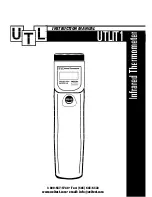
LCD Error Messages
The thermometer incorporates visual diagnostic messages as follows:
:
“
E 4
” Need re-calibrate, please return to the store or
authorized lab.
:
“
E 6
” Part damaged, return the unit to the store you
purchased for repairing.
M a i n t e n a n c e
Periodic Service
WARNING!
Repair and service of this instrument is to be performed by qualified
personnel only.
Cleaning
Pe r i o d i cally clean your instrument’s case using a damp cloth.
DO NOT
use abrasive, flammable liquids, cleaning solvents, or strong detergents as
they may damage the finish, impair safety, or affect the reliability of the
s t r u c t u ral components.
Battery Replacement
Always use a fresh replacement battery of the specified size and type.
Immediately remove the old or weak battery from the meter and
dispose of it in accordance with your local disposal regulations. Old or
defective batteries can leak chemicals that corrode electronic circuits.
A flashing display is the indication that the battery voltage has fallen
into the critical region (6.5 to 7.5 V). Reliable readings can be obtained
for several hours after the first appearance of the low battery indication.
Open the battery compartment and remove the battery, then install a
new battery and replace the cover.
WARNING!
Under
NO
circumstance should you expose batteries to extreme heat or
fire as they may explode and cause injury.
Lens Care
The sensor lens is the most delicate part of the thermometer. The lens
should be kept clean at all times. Care should be taken when cleaning
the lens using only a soft cloth or cotton swab with water or medical
alcohol. Allowing the lens to fully dry before using the thermometer. Do
not submerge any part of the thermometer in liquids.
Taking Measurements
To take a temperature measurement using your UTLIT1, you simply
point the aperture at an object and push the “
MEAS
” button. The
object’s temperature will show up on the display.
There will be a delay of approximately one-second between the time
you initially push the “
MEAS
” button and the time the display
comes on.
NOTE:
This thermometer will automatically shut off if left idle for more
than 4 seconds.
Follow these general guidelines to ensure you get the most accurate
readings possible:
• Be sure the measured object fills the "
spot
"
seen by the aperture. The distance to spot ratio
for the UTLIT1 is 5:1.
• Not recommended for measuring shiny or reflective
surfaces. Place the meter as close as possible when
measuring small objects.
• The meter is pre-set to measure objects with an emissivity of
0.95. This will accommodate the majority of items measured
without compensating for higher or lower value. In most cases
there will be little difference in measurements even if an object's
emissivity is higher or lower than this pre-set value. Compare
and confirm with known values if in doubt.
This shows the one-foot spot fitting within the one-foot target area. At
this distance, and anything closer, the target’s temperature will be
accurately measured (Fig 1).
NOTE:
If the two-foot diameter spot includes unwanted objects in the
background that are not part of the one-foot target, the temperature of
the background objects will be figured in with the target’s temperature
and cause errors in your measurements.
Data Hold
This meter automatically holds the last temperature reading on the LDC
for 4-5 seconds after the MEAS key is released.
No extra key presses are necessary to freeze the displayed reading.
Measurement Considerations
Holding the meter by its handle, point the IR Sensor toward the object
whose temperature is to be measured. The meter automatically
compensates for temperature deviations form ambient temperature.
Keep in mind that it will take up to 30 minutes to adjust to wide
ambient temperature changes. When low temperatures are to be
measured followed by high temperature measurements, some time
(several minutes) is required after the low (and before the high)
temperature measurements are made. This is a result of the cooling
process which must take place for the IR sensor.
UTLIT1-MAN
P. 2
(Fig 1)























